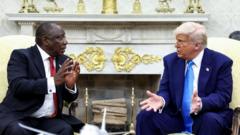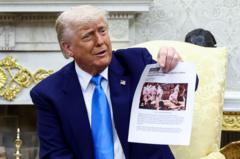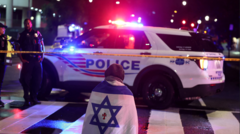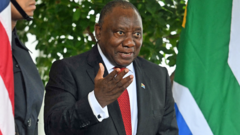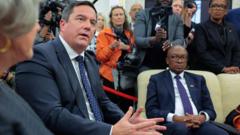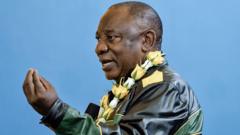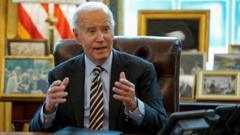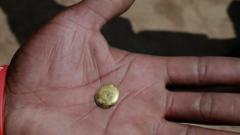Fact-checking reveals significant inaccuracies in Trump's assertions about violence in South Africa.
**Confrontation at the White House: Trump and Ramaphosa's Clash Over South Africa's Issues**

**Confrontation at the White House: Trump and Ramaphosa's Clash Over South Africa's Issues**
In a heated exchange, Donald Trump challenged South African President Cyril Ramaphosa regarding the claims of violence against white farmers, raising questions about the presentation of facts.
In a dramatic meeting at the Oval Office on Wednesday, former President Donald Trump confronted South African President Cyril Ramaphosa over contentious allegations related to violence against white farmers in South Africa. The atmosphere shifted from cordial to confrontational when Trump prompted his aides to display a video that featured South African politicians allegedly inciting violence.
Using a series of visuals, Trump claimed that rows of white crosses he presented symbolized grave sites for murdered white farmers. However, this footage was misrepresented, as it actually depicted a memorial created for a farming couple, Glen and Vida Rafferty, who were tragically killed in 2020. Rob Hoatson, an event organizer, clarified that the crosses were a temporary tribute and have since been removed.
Moreover, Trump's allegations regarding a supposed "genocide" of white farmers also lack credible support. The South African Police Service reported a total of 26,232 murders last year but identified only eight of those as being farmers, questioning the validity of Trump's repeated claims. A South African judge previously dismissed the concept of genocide against white farmers as "clearly imagined."
Trump also showed a video that included a controversial song, "Kill the Boer," during his discussion. Although this song has been recognized as hate speech in some circles, it has been deemed permissible in political contexts by recent court decisions, with Ramaphosa stressing that the governing party does not support such actions.
In presenting articles to substantiate his claims, Trump displayed an image that was later confirmed to have come from a report on violence in the Democratic Republic of Congo rather than from South Africa, further undermining his credibility.
This incident underscored not only the complexities of race relations in South Africa but also the potential for misinformation to influence international narratives and relations.



